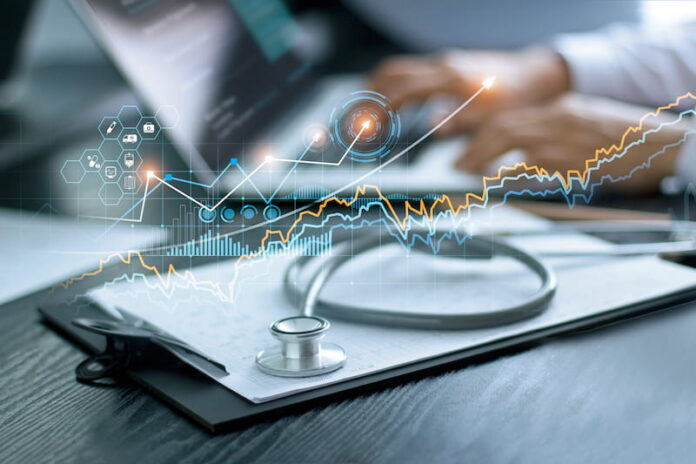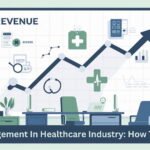Imagine a healthcare system where doctors can predict and prevent illnesses before they become severe. This is not science fiction but a reality brought to life. So, what makes this possible? It’s the incredible force of data. That’s correct!
Gone are the days when medical decisions were solely based on intuition and experience. Today, healthcare providers are leveraging the vast amounts of data generated within the healthcare system. This data has let them make informed decisions to improve patient outcomes.
In this blog post, we will take a closer look at how data-driven approaches are revolutionizing the healthcare landscape.
Electronic Health Records
Electronic Health Records are digital versions of a patient’s medical history, treatment plans, test results, and more. Due to their numerous advantages, they have replaced traditional paper-based records in most healthcare settings.
One of the primary benefits of EHRs is accessibility. When a patient’s medical information is stored electronically, it can be quickly retrieved by authorized healthcare professionals during emergencies. As a result, it helps improve the speed and accuracy of diagnosis and treatment.
But remember, managing patient data effectively is fundamental to healthcare delivery. For this, having a Data Governance Framework is crucial. It is a set of policies, procedures, and standards that ensure data quality, security, and compliance. In the context of EHRs, it helps maintain the integrity and privacy of patient information.
Predictive Analytics for Early Intervention
Predictive analytics in healthcare is like having a crystal ball that can help foresee health risks before they become serious. It’s a powerful tool that enables doctors to take proactive measures, resulting in improved patient outcomes.
One of the key benefits of predictive analytics is its ability to identify health risks and early signs of illness. By analyzing large datasets of patient information, predictive models can detect patterns that might be missed by human observation alone.
For example, these models can identify individuals who are at a higher risk of developing conditions like diabetes or heart disease based on their lifestyle, genetics, and health history.
Another significant advantage of predictive analytics is its role in reducing hospital readmissions. By tailoring post-discharge care plans to individual needs, hospitals can reduce readmissions. This is beneficial and cost-effective for patients.
Personalized Medicine and Treatment Plans
Personalized medicine is all about tailoring treatments to individual needs. Instead of using a standard treatment designed for the average person, doctors are now using patient data to create treatment plans. They are specific to each patient’s body and condition.
So, how does it work? It starts with gathering a lot of information about the patient. This includes things like their genetic makeup, their medical history, and even their lifestyle. With all this data in hand, doctors can pinpoint the best treatment options for that particular patient.
One significant benefit of personalized medicine is that it can improve medication adherence. When patients feel like their treatment plan is designed just for them, they’re more likely to follow it closely. This means taking medications as prescribed and making the necessary lifestyle changes.
But personalized medicine isn’t just about better outcomes; it’s also about patient satisfaction. When patients see that their doctors are taking the time to understand their unique needs, it builds trust and confidence in the healthcare system.
Telehealth and Remote Monitoring
Telehealth and remote monitoring are rapidly gaining importance in modern healthcare. These practices are changing the way healthcare is delivered, making it more accessible and effective for patients.
The rising importance of telehealth in data-driven healthcare is evident in the way it leverages technology to connect patients with healthcare providers. Telehealth allows patients to consult with doctors and specialists remotely, reducing the need for in-person visits. This is especially beneficial for patients who live in rural or underserved areas, where access to healthcare can be limited.
Remote monitoring is another key aspect of data-driven healthcare. It involves the use of devices and sensors to track a patient’s vital signs, chronic conditions, and overall health. This data is transmitted to healthcare professionals in real time. As a result, it enables them to monitor a patient’s health status continuously. This proactive approach allows for early detection of issues and timely interventions, significantly improving patient outcomes.
Conclusion
Finally, it’s clear that we stand at a transformative time in the world of medicine. The integration of data into healthcare practices is not just an innovation. It holds the promise of more informed healthcare decisions, better patient experiences, and a new era of medical breakthroughs. As technology continues to evolve, so will the ways we can use data to enrich lives and foster healthier communities. So, let’s embrace this future with optimism and a commitment to continual learning and adaptation.
Did you find this helpful? Check out our other helpful articles on our website.
Read Also
- How to Drive Growth Through Customer Centricity in HealthcareThe world of healthcare is changing in big ways. Consumers are now stepping up and taking charge of their health journeys. This change is happening now for important reasons. The U.S. health and wellness market is huge, projected to be over $6 trillion in 2025. This growth is fueled by rising out-of-pocket costs and more… Read more: How to Drive Growth Through Customer Centricity in Healthcare
- Maximizing Digital Reach for Podiatry Clinics in Local HealthcareMaximizing Digital Reach for Podiatry Clinics in Local Healthcare As the healthcare industry evolves, mobile marketing becomes indispensable for practitioners. Podiatry clinics, focusing on foot and ankle care, must adapt to digital strategies to engage patients effectively. Implementing tailored SEO practices is crucial for these clinics to thrive in an increasingly competitive market. Digital marketing… Read more: Maximizing Digital Reach for Podiatry Clinics in Local Healthcare
- Leveraging Virtual Medical Assistants to Maximize Operational Efficiency in HealthcareIn the increasingly complex and fast-paced world of healthcare, operational efficiency is critical. Doctors and healthcare administrators are faced with numerous challenges, from managing patient scheduling and medical billing to adhering to stringent regulatory compliance and insurance claims processing. These tasks, while essential, often divert time and resources away from the core mission of providing… Read more: Leveraging Virtual Medical Assistants to Maximize Operational Efficiency in Healthcare
- Optimizing CT Protocols: The Hidden Key to Efficiency and Cost Savings in RadiologyIntroduction: Why CT Protocol Optimization Matters Computed Tomography (CT) is a cornerstone of modern diagnostic imaging, providing critical information across nearly every medical specialty. However, maximizing the value of CT — both clinically and financially — requires more than just advanced hardware. The real secret lies in the optimization of CT protocols. When CT protocols… Read more: Optimizing CT Protocols: The Hidden Key to Efficiency and Cost Savings in Radiology
- Hospital Discharge Accuracy Improves With Daily Advisor InvolvementThe hospital discharge process has a big effect on patient recovery, hospital efficiency, and finances. It requires careful planning and clear communication between team members to make sure patients get the right care when they leave the hospital. Having physician advisors involved at this stage can improve the discharge process by spotting problems that need… Read more: Hospital Discharge Accuracy Improves With Daily Advisor Involvement
- Understanding Clinical Trials: What to Learn and the RoadblocksClinical trials are research studies conducted to determine the efficacy of medical, surgical or behavioral interventions. They are the most commonly used way that researchers assess whether new treatments, drugs or medical devices are safe and effective for use in humans. There are strict protocols governing these studies, and all of this is done in such a… Read more: Understanding Clinical Trials: What to Learn and the Roadblocks
- The Patient’s Voice: 7 Ways to Improve TelehealthTelehealth has transformed how we access healthcare, making it more convenient and accessible than ever before. However, as this technology evolves, so does the need for improvement. Patient feedback is essential in shaping these telehealth experiences. It offers valuable insights into what works, what doesn’t, and how we can make virtual care even better. Currently,… Read more: The Patient’s Voice: 7 Ways to Improve Telehealth
- How to Overcome Healthcare Claim Denial Challenges and Increase RevenueTable of Content Understanding Major Challenges in Healthcare Claim Denial Management Financial Impact of Healthcare Claim Denials Optimizing the procedure Important Strategies for Managing and Resolving Denials Understanding Major Challenges in Healthcare Claim Denial Management Healthcare Claim Denials have become a major challenge for healthcare providers and administrators. Such denials not only delay payments but… Read more: How to Overcome Healthcare Claim Denial Challenges and Increase Revenue









